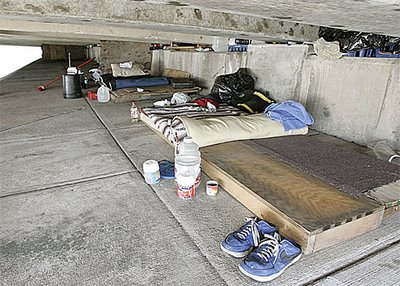 PUTNAM COUNTY, FL. – America’s battle to control sex offenders has taken a drastic turn in Florida, where homeless men convicted of sex crimes and labeled sex offenders have been assigned to live under bridges after release from jail.
PUTNAM COUNTY, FL. – America’s battle to control sex offenders has taken a drastic turn in Florida, where homeless men convicted of sex crimes and labeled sex offenders have been assigned to live under bridges after release from jail.
While the fact of homeless sex offenders living under bridges is not new, the fact that the Department of Corrections is actually making a bridge an official domecile and assigning offenders to “live” there has some people wondering if the state’s program is functional.
The problem, according to legal observers, is an ordinance passed in 2005 by Miami-Dade County that forbids people convicted of sex crimes with minors from living within 2500 feet of schools, playgrounds or even school bus stops. The previous law had mandated a distance of 1000 feet.
All in all, about 100 Florida cities have adopted the ordinance, creating a situation that all but guarantees a high recidivism rate among the homeless sex offender population.
“Because of the conditions, some of these individuals are absconding, evading supervision,” Howard Simon, executive director of the American Civil Liberties Union of Florida, said. “These ordinances interfere with the Department of Corrections ability to keep track of them. This is a crisis situation.”
Recently, South Florida newspapers have recounted the story of Causey Guyden, a 43-year-old sex offender who had been assigned to live under the Dunns Creek Bridge.
“They directed him to live at the [bridge] because it’s the only place in Putnam County that a sex offender can go and stay,” Bob Davis, Guyden’s attorney, said.
Corrections says their hands are tied. According to spokesperson Gretl Plessinger, probation officers have to have a place to check on offenders and many times it is not a home, but their cars or even under a bridge. Currently, he added, there are 91 homeless sex offenders in Florida, most of them in the southern part of the state.
“Unfortunately, this is not a new issue for the department,” Plessigner said. “We’ve been dealing with this for a few years now. We see our numbers slowly increase. So, this is a problem that needs to be addressed. We know this is not a good situation.”
In Guydan’s case, the hardship of having to abide by all the normal probation requirements while living under a bridge was shortlived. he was supposed to stay put during his curfew hours, from 6:00 p.m. to 7:00 a.m., but when officers went to check on him his first day, he wasn’t at the bridge four hours after his curfew began.
He is now back in prison.












No Comment